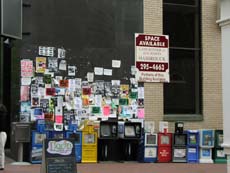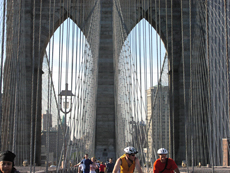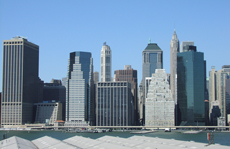Suggestions about accentuating linkage

Informal community links

Highway sign pointing to towns in Maine

Cables on the Brooklyn Bridge that linked two cities and made them one.

Commuters returning from Manhattan across the Brooklyn Bridge.

Lower Manhattan, seen from Brooklyn, testifies to forces, interests, and decisions shaping today's places. The absence of the WTC on the skyline testifies as well.

Multiple social grammars coexisting (outside the Bank of China, Hong Kong)
Suburban places need to show more explicitly how they exist within larger systems, social contexts, and their genetic processes. They should not enforce the illusion that their social and spatial structures are immediately given and natural. Might there be means to accentuate a sense of the interdependence and intersection of the local with larger environmental, economic, and political forces? It is important to become aware of the political and economic processes, the systemic pressures and constraints, the varied interest groups within and outside the place, and their procedures of negotiation or imposition, and then intervening in or redirecting those processes.
If suburbanites were more aware of their linkages and common interests across jurisdictional boundaries, new political coalitions might develop. This has happened with many environmental issues and transportation policies. Such new voices could come from new institutions or from temporary bottom-up groups that come and go in response to local situations. Some ways of stimulating such awareness and action might include:
- To increase the sense of environmental issues, could we resume Louis Sullivan's search for decoration based on the local natural environment?
- Are there ways of acknowledging far horizons by gestures towards them? Could we make more public use of maps and signposts that show distant as well as local destinations? To remind us that the suburb is not self-contained, what if there were some public equivalent of those walls of screens bearing images from all over the world that we see in the background of TV news shows?
- Are there ways of showing multiple social grammars in suburbia, to undercut spatial segregation by class and life-style? Ethnic migrations, increased choices in popular culture, and varied Internet resources are bringing more cultural diversity to similar looking suburbs. What ways might be found to make visible the differing norms for family, children, work, or leisure? Some people are using lawn ornaments and banners as assertions of individuality or affiliation; should such decorations and symbols be multiplied?
- Even though we can't rebuild all those houses and office buildings, could we alter architectural details to celebrate interdependence and the intersection of the local and global? For instance, strange as it may sound, could we find ways to highlight and make significant those antennas and loading docks, those delivery trucks, receiving boxes, transformers, lines, pipes, towers, trash bins -- all those signs of insertion into larger processes and patterns -- and kinds of work -- that we usually hide, or pretend are invisible?
- People dislike the intrusion of mobile phone antenna towers poking up everywhere. Yet as they replace wires marching across the countryside, the towers remind us that links now work in non-concentric, non-hierarchical ways, in all directions. Could we find designs for those towers that was inexpensive and sturdy yet something a community could see as a celebration of its connections and reach?
- What if we labeled more products with their provenance(s) in local or other communities? Designed local styles for transit stops or bicycle sheds or parking lots?
Most important, though, is that the norms and expectations of the place acknowledge its linkages and flows, so that these are not taken as intrusions on some whole that was supposed to be bounded and complete.
Awareness of the complexity of the local scene provides awareness of interstices and openings for action and intervention. This could increase the political complexity of an area by creating more opportunities and voices for dialogue about and with larger forces and pressures. More agents can be brought onto the political and economic scene. This is happening as tentative regional collaborations, non-governmental organizations, and other new and old civic groupings begin to make their voices heard.
- Suggestions about planning for greater density
- Suggestions about style and architecture
- Suggestions about awareness of ongoing processes
- Return to "some hesistant suggestions"
- [Nearby: Sprawl Outline -- Suggestions about style and architecture -- A Swedish example ]